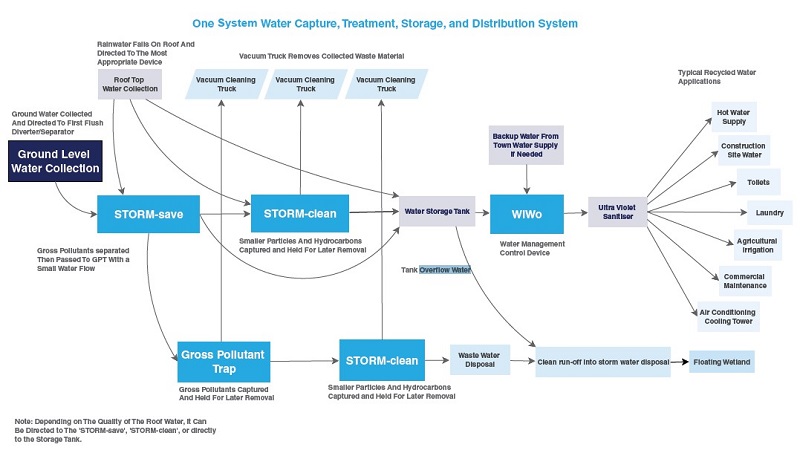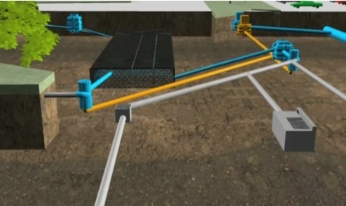
Treatment Train
 Our SPARKLE | WATER | QUALITY inovation steps ahead of the legacy overbourn Wetland and GPT approach to stormwater management.
Our SPARKLE | WATER | QUALITY inovation steps ahead of the legacy overbourn Wetland and GPT approach to stormwater management.
The SPARKLE | WATER | QUALITY treatment train has been developed as a systemised approach in an inovative Micro Distributed Catchment Model (MDCM) treatment train that can manage rainwater collected from a range of water sources incluing clean roof catchments, vegitated or hard surface catchments and can be engineered to flood level mitigation. The SPARKLE | WATER | QUALITY system is equally suitable for low cost retrofitting, civil, infrastructure and municipal works and greenfield developments in WSUD.
Nature has largely been overwhelmed in the urban space and it is clear that every WSUD needs supportive natural and mechanical integration and effective maintenance where systems need to be reset for each storm event without adding to the contamination of the next water flow through the already contaminated device. Bottom of catchment systems like cost off-set Wetlands and ever larger GPT sumps to avoid maintenacee are failing - contaminating the whole water flows from the whole of the catchment to the highest level of contamination in that catchment - and then we are wasting the resource in the nearest convenient waterway!!!
Vegitated catchments can marginally reduce some of the elements of the contaminate load in the flow channels albeit temporarilly but hard-surfaces and high traffic areas generally need higher level treatment in the essential protection of the land environment and waterways stream ecology with mmore effective stormwater management. In the expanding urban developments of unweilding size and contaminated catchments effective stormwater management cannot happen withoiut systemised engineered design and support! Innovative, low cost and modular product solutions are needed as supported system for nature and its far superior biology.
The system shown here is receiving rainwater and stormwater, displayed under a trafficable area of a commercial site demonstrating capacity and scope of the systemised MDCM.
Roof collected water can also be fed through a STORM_save(pat.) that has multiple configurations as a hydrodynamic and spiral generated form seperator and First Flush device - considered essential to improving water quality. The STORM_save(pat.) device will always separate the flows into harvested water as the bulk of the flows - the first channel (approx 2/3 flow) and the residual high contaminate loading that is passed along to the drainage system where our contaminate reductions treatments take place with substantially less water - second channel (approx 1/3 flow) to process. Equally our harvested flows can be processed under beneficial conditions with higher flow rate with the harvested water flows at a reduced contaminate load for finer filtration within the system of water quality improvement treatment.
Harvested surface water generally requires a higher level of treatment than clean roof catchments and is therefore passed to a subsequent inline STORM_clean device that acts as a fine filter and barrier to downstream contamination before the improved water quality is sent into storage or release.
The higher contaminate loaded First Flush (second channel) water flow - with all the gross pollutants - can be channeled to a STORM_gpt where the larger pollutants like organics, sediment and refuse are now processed to further seperate out and held for vacumn removal. The gross pollutant eliminated water flow is then filtered by a separate (second channel) STORM_clean to reduce nutrients, hydrocarbon and particulated soluable elements before the two streams can be again combined for harvesting or released to the natural environment like wetlands or discharge waterways.
These capture processes provide a harvested resource where the subsequent water flows are received into an underground storage tank as a maintained healthy water resource for later use including in toilets flushing, irrigation, washdowns etc. or as released / managed stormwater in the water cycle that is healthy and sustainable for waterway ecology and natural biological processes. Storage is therefore considered essential as this SPARKLE | WATER | QUALITY system also provides for HRT and biological support to maintain the healthy water resource for either reuse or release.
SPARKLE | WATER | QUALITY system approach is a complete compact low energy system of water quality improvement for full (even flooding) water flows.






 LinkedIn
LinkedIn WeChat
WeChat

